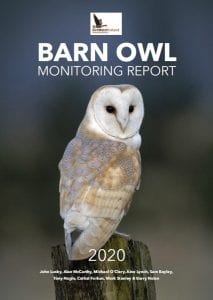Barn Owls in a chimney nest in a ruined building (left) © John Lusby. A ruined workhouse which has been used by Barn Owls for many years (right) © Michael O’Clery
It is important to recognise our failures when it comes to protecting biodiversity, but also important to acknowledge and celebrate conservation successes. Last summer provided many reasons to celebrate in terms of Barn Owl conservation. It was a record setting year on many fronts, all of which were positive. Last summer was the most productive breeding season for Barn Owls in Ireland on record. The highest uptake of nest boxes was also recorded in 2020. After decades of population declines, Barn Owls are showing the early signs of recovery in certain parts of their range in Ireland. You can read the Barn Owl Monitoring Report 2020 here.
Each year we monitor Barn Owl occupancy and breeding performance at selected sites throughout the country to inform their population and breeding trends. This information allows us to assess the health of the population and to identify the factors which influence Barn Owl populations on a local and national level, which helps to inform their conservation requirements, and to determine the effectiveness of existing conservation measures.
 A Barn Owl nest in a hollow tree cavity © John Lusby
A Barn Owl nest in a hollow tree cavity © John Lusby
The Barn Owl monitoring highlighted 2020 as the most productive breeding season for Barn Owls on record. In 2020, 192 sites were confirmed to be occupied by Barn Owl. This is the highest number of occupied Barn Owl sites confirmed in Ireland in a single year. Many of these sites, which are predominantly in buildings including farm buildings, castles, farmhouses and ruined mansions have been used by Barn Owl for more than ten years and some sites are known to have been occupied by Barn Owl for more than 25 years, which shows the importance of traditional nesting sites and the importance of ensuring these sites are protected.
 Map showing the number of Barn Owl breeding sites recorded in each county in 2020 (left). A castle which has been used by Barn Owl for over 25 years © John Lusby
Map showing the number of Barn Owl breeding sites recorded in each county in 2020 (left). A castle which has been used by Barn Owl for over 25 years © John Lusby
In 2020, 59 nest boxes were used by breeding Barn Owl. This is the highest number of occupied nest boxes recorded in Ireland to date, and this number continues to increase each year. This shows the value of the provision of nest boxes which is carried out by many groups and individuals across the country.
 Nest boxes installed for Barn Owls both of which are used for breeding © Michael O’Clery (left) and John Lusby (right)
Nest boxes installed for Barn Owls both of which are used for breeding © Michael O’Clery (left) and John Lusby (right)
Barn Owls had a productivity of three young per breeding attempt in 2020, which is the highest productivity recorded in a single year in Ireland. It was also the earliest breeding season on record, with an average laying date of the 8th of April in 2020. Some pairs had a second brood, meaning that monitoring of young hatched in 2020 continued into the early months of 2021.
 A Barn Owl chick which was fitted with a ring (left) © Dario Fernandez-Bellon. The productivity of Barn Owls in Ireland between 20210 and 2020 (right)
A Barn Owl chick which was fitted with a ring (left) © Dario Fernandez-Bellon. The productivity of Barn Owls in Ireland between 20210 and 2020 (right)
Although Barn Owls have declined in range and numbers over recent decades, there are early indications that Barn Owl populations are recovering in certain parts of their range in Ireland. There has been a significant focus on addressing the factors which are known to impact Barn Owl populations. Conservation efforts including the protection of known nest sites and the provision of nest boxes have proven successful. The implementation of survey standards and mitigation measures for national road projects will also hopefully serve to reduce the effects of road developments and extent of vehicle collisions. Efforts to improve awareness and standards regarding the control of rodents, to minimise the effects of secondary poisoning of rodenticides are ongoing, however this remains a significant threat to Barn Owl populations and other wildlife in Ireland.
In addition to the conservation initiatives implemented, there has also been significant changes in the Irish landscape which can affect Barn Owls and other predatory species, most notably the introduction and range expansion of introduced small mammal species (primarily the Bank Vole and Greater White toothed Shrew). It is important to identify any changes in Barn Owl population and breeding trends and to understand and respond to the drivers of these population changes.
 The Greater White toothed Shrew (left © John Murphy), is now one of the main prey items for Barn Owls (right © Mike Brown) throughout their breeding range in Ireland
The Greater White toothed Shrew (left © John Murphy), is now one of the main prey items for Barn Owls (right © Mike Brown) throughout their breeding range in Ireland
At present we are undertaking survey work and monitoring to assess Barn Owl populations in parts of the country which have not received much attention in recent years, to better understand how Barn Owls are faring in these areas, to ensure nest sites are protected and to inform conservation measures including nest box schemes. We are looking for your help to assist with the surveys. If you have information on Barn Owls, whether it be knowledge of a potential nest site, or if you know of a nest box installed for Barn Owls, please let us know, as this greatly helps our survey efforts and our understanding of Barn Owl populations, you can report all information here: https://birdwatchireland.ie/our-work/surveys-research/research-monitoring/raptors/barn-owl-survey/
You can view the report of the Barn Owl monitoring in 2020 below, which also includes a range of case studies which showcase the different aspects of the monitoring, including Barn Owl rescues and nest box schemes.
The Barn Owl monitoring and conservation efforts in 2020 received the support of Galway County Council and Creative Ireland in Galway. Cork County Council through the Environment Directorate and Tipperary County Council (Heritage Office) provided funding for the monitoring activities, the cost of rings and travel in each respective county. In Duhallow (north Cork and east Kerry) the monitoring was funded as part of the Duhallow Barn Owl Conservation Project funded by IRD Duhallow in association with the Duhallow Birdwatching Group through the Leader Programme. In previous years, Dublin Zoo have supported the Barn Owl monitoring and conservation work, however this was not possible in 2020 due to the Covid-19 pandemic, and we would like to thank Dublin Zoo for their support up to 2020. Funding for the Laois Barn Owl Project (materials for indoor and outdoor boxes) was provided through Laois County Council and Gas Networks Ireland.
In 2021 the Barn Owl monitoring and conservation work is supported by Galway County Council, Mayo County Council, Westmeath County Council, Offaly County Council, Tipperary County Council Council, Kilkenny County Council and Kerry County Council through the National Biodiversity Action Plan Fund of the Department of Housing, Planning and Local Government, Cork County Council through the Environment Directorate and Dublin Zoo. The funding provided is used for Barn Owl surveys and monitoring, implementing new nest box schemes, designing and implementing conservation measures including the production of conservation guidance in relation to rodenticides, habitat creation and management and also assessing the range expansion and impacts of non-native small mammals.

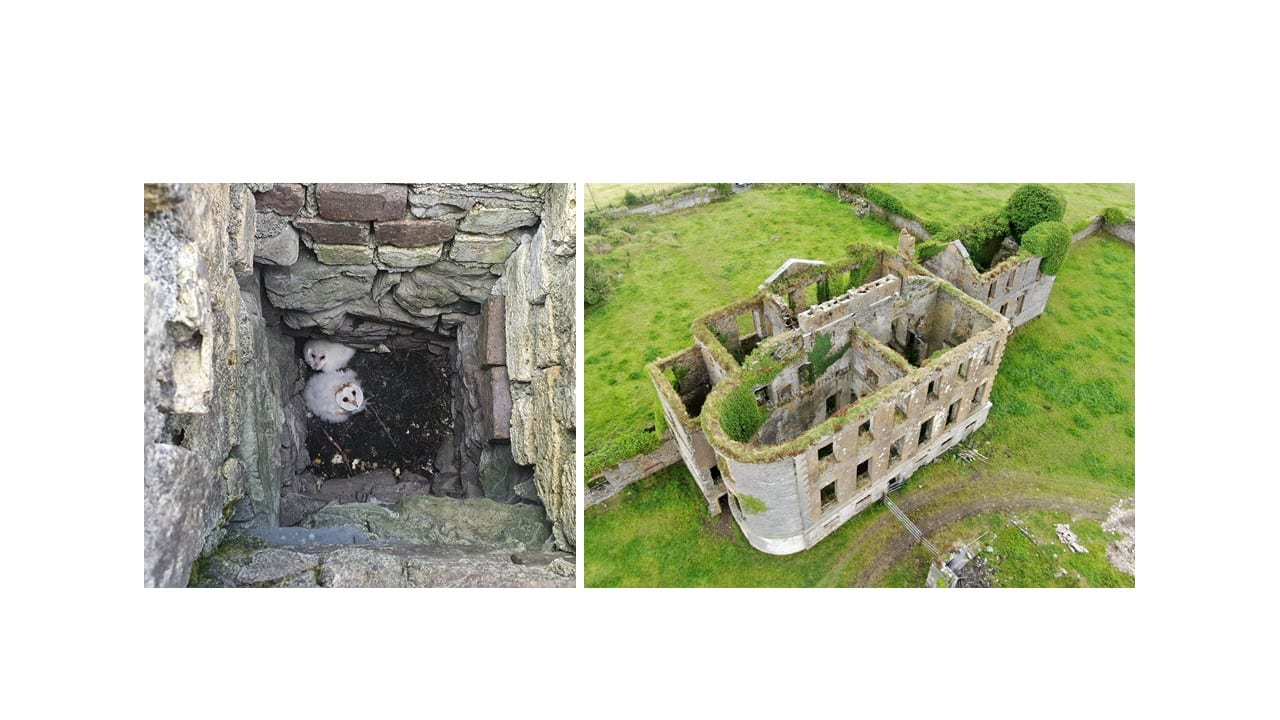
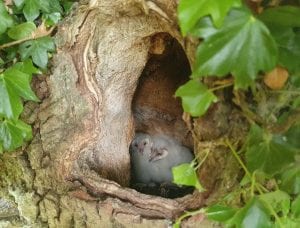 A Barn Owl nest in a hollow tree cavity © John Lusby
A Barn Owl nest in a hollow tree cavity © John Lusby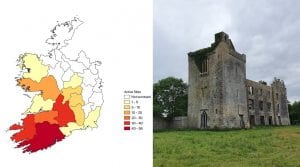 Map showing the number of Barn Owl breeding sites recorded in each county in 2020 (left). A castle which has been used by Barn Owl for over 25 years © John Lusby
Map showing the number of Barn Owl breeding sites recorded in each county in 2020 (left). A castle which has been used by Barn Owl for over 25 years © John Lusby Nest boxes installed for Barn Owls both of which are used for breeding © Michael O’Clery (left) and John Lusby (right)
Nest boxes installed for Barn Owls both of which are used for breeding © Michael O’Clery (left) and John Lusby (right)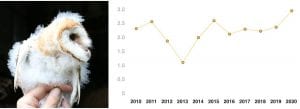 A Barn Owl chick which was fitted with a ring (left) © Dario Fernandez-Bellon. The productivity of Barn Owls in Ireland between 20210 and 2020 (right)
A Barn Owl chick which was fitted with a ring (left) © Dario Fernandez-Bellon. The productivity of Barn Owls in Ireland between 20210 and 2020 (right) The Greater White toothed Shrew (left © John Murphy), is now one of the main prey items for Barn Owls (right © Mike Brown) throughout their breeding range in Ireland
The Greater White toothed Shrew (left © John Murphy), is now one of the main prey items for Barn Owls (right © Mike Brown) throughout their breeding range in Ireland